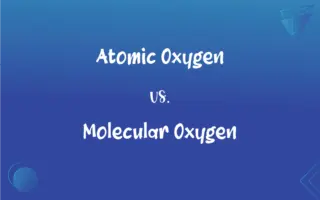DNA Methylation vs. Histone Acetylation: What's the Difference?
Edited by Janet White || By Harlon Moss || Published on March 20, 2024
DNA Methylation is a biochemical process adding a methyl group to DNA, often silencing gene expression. Histone Acetylation is the addition of acetyl groups to histone proteins, generally promoting gene expression.

Key Differences
DNA methylation involves adding a methyl group to the DNA molecule, typically at cytosine bases. This process is often associated with the repression of gene expression, as it changes the way genes interact with the cellular machinery. Histone acetylation, in contrast, involves adding acetyl groups to histone proteins, which are crucial for DNA packaging in cells. This modification usually leads to the activation of gene expression by loosening the DNA-histone interaction, making the DNA more accessible for transcription.
The role of DNA methylation is crucial in development, as it helps in cellular differentiation by selectively silencing genes. It's a form of epigenetic modification that can be inherited through cell divisions. Histone acetylation, conversely, plays a key role in regulating gene expression dynamically. It can rapidly change in response to various cellular signals, thereby influencing gene activity and overall cellular function.
Abnormalities in DNA methylation patterns are linked to various diseases, including cancer, where hypermethylation can lead to tumor suppressor gene silencing. This process is a key factor in epigenetic therapy. Histone acetylation also has significant implications in disease, especially in the context of chromatin remodeling disorders and cancer, where altered acetylation patterns affect gene expression profiles.
DNA methylation is often considered a stable and long-term regulatory mechanism. Its effects on gene expression are generally persistent and can be maintained across generations. Histone acetylation, on the other hand, is more dynamic and reversible, allowing cells to rapidly respond to environmental changes or developmental signals.
Both DNA methylation and histone acetylation are crucial for the fine-tuning of gene expression, but they operate through different mechanisms. DNA methylation typically suppresses gene expression, contributing to long-term cellular memory, while histone acetylation tends to enhance gene expression, playing a role in rapid gene regulation.
ADVERTISEMENT
Comparison Chart
Effect on Gene Expression
Generally represses
Generally activates
Type of Modification
Addition of methyl groups
Addition of acetyl groups
Location
On DNA, primarily cytosine bases
On histone proteins
Stability
Long-term and stable
Dynamic and reversible
Role in Disease
Linked to cancer, gene silencing
Implicated in chromatin disorders, gene activation
ADVERTISEMENT
DNA Methylation and Histone Acetylation Definitions
DNA Methylation
Regulatory process in cell differentiation.
DNA methylation plays a crucial role in embryonic development.
Histone Acetylation
Mechanism for gene expression activation.
Histone acetylation is a key process in turning genes on.
DNA Methylation
Epigenetic mechanism controlling gene expression.
In cancer, abnormal DNA methylation patterns can be observed.
Histone Acetylation
Dynamic and reversible modification.
Cellular responses to environmental changes often involve histone acetylation.
DNA Methylation
Addition of a methyl group to DNA.
DNA methylation at specific gene sites can lead to gene silencing.
Histone Acetylation
Influence on DNA accessibility.
Acetylation makes DNA more accessible for transcription factors.
DNA Methylation
Alteration of DNA without changing sequence.
DNA methylation modifies the gene activity without altering the DNA sequence.
Histone Acetylation
Addition of acetyl groups to histone proteins.
Histone acetylation relaxes DNA around histones, enhancing gene expression.
DNA Methylation
Inheritance of gene expression patterns.
Methylation patterns can be passed down through cell generations.
Histone Acetylation
Regulation of chromatin structure and function.
Changes in histone acetylation can alter chromatin dynamics.
FAQs
What role does DNA methylation play in development?
It's crucial for cell differentiation and developmental processes.
What enzymes are involved in DNA methylation?
DNA methyltransferases are key enzymes in this process.
What is the primary function of DNA methylation?
It primarily silences or downregulates gene expression.
How does histone acetylation affect gene expression?
It generally activates or upregulates gene expression.
Is DNA methylation a reversible process?
It can be reversible but is generally considered a stable change.
Is DNA methylation heritable?
Yes, methylation patterns can be inherited through cell divisions.
Can histone acetylation be quickly reversed?
Yes, it's a dynamic process that can be rapidly altered.
What is the impact of DNA methylation on gene regions?
It typically leads to the repression of gene regions.
Can lifestyle affect histone acetylation?
Yes, factors like diet and stress can impact acetylation.
How does aging affect DNA methylation?
Aging can lead to changes in methylation patterns.
Does histone acetylation play a role in memory formation?
Yes, it's involved in gene expression related to memory.
How does histone acetylation influence chromatin structure?
It loosens chromatin structure, making DNA more accessible.
What enzymes regulate histone acetylation?
Histone acetyltransferases (HATs) and deacetylases (HDACs) are involved.
Are abnormalities in DNA methylation linked to diseases?
Yes, especially in various forms of cancer.
How does the environment influence DNA methylation?
Environmental factors can cause changes in methylation patterns.
Can DNA methylation be measured?
Yes, using various molecular biology techniques.
Can histone acetylation patterns be altered in diseases?
Yes, particularly in cancer and chromatin remodeling disorders.
Does histone acetylation impact all genes equally?
No, it affects genes differently depending on the cellular context.
Is DNA methylation used in epigenetic therapy?
Yes, particularly in targeting cancer.
Are there drugs that target histone acetylation?
Yes, HDAC inhibitors are used in certain therapies.
About Author
Written by
Harlon MossHarlon is a seasoned quality moderator and accomplished content writer for Difference Wiki. An alumnus of the prestigious University of California, he earned his degree in Computer Science. Leveraging his academic background, Harlon brings a meticulous and informed perspective to his work, ensuring content accuracy and excellence.
Edited by
Janet WhiteJanet White has been an esteemed writer and blogger for Difference Wiki. Holding a Master's degree in Science and Medical Journalism from the prestigious Boston University, she has consistently demonstrated her expertise and passion for her field. When she's not immersed in her work, Janet relishes her time exercising, delving into a good book, and cherishing moments with friends and family.






































































